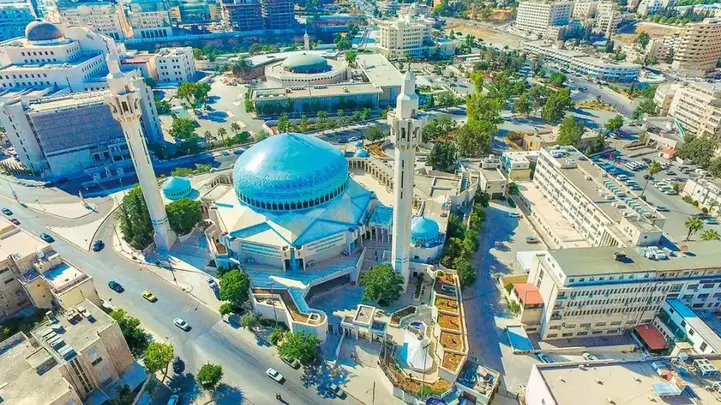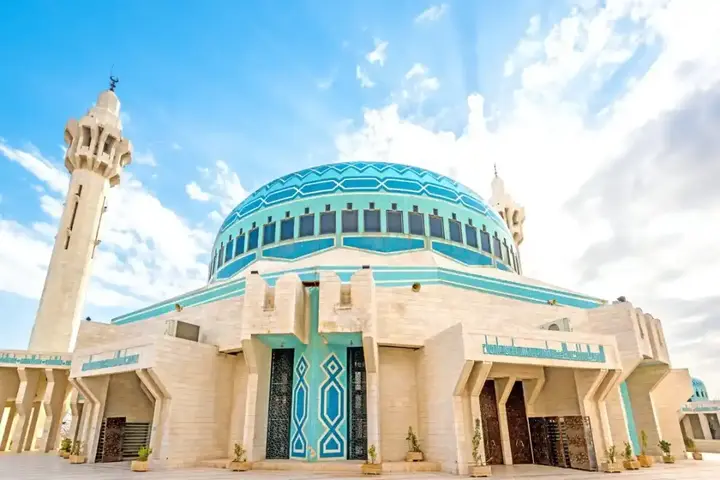The pearl of Amman's mosques King Abdullah I Mosque in the Kingdom of Jordan
The mosque and the capital of a free kingdom

The mosque and the capital of a free kingdom
Show key points
- King Abdullah I, the founder of modern Jordan, laid the foundation for the country's independence and unity, realizing the dream of his father, Sharif Hussein.
- King Hussein bin Talal built the King Abdullah I Mosque in honor of his grandfather, beginning construction in 1982 and completing it over a span of seven years.
- The mosque's external design features a striking blue and white color scheme and a semicircular dome reflecting classical Islamic architectural styles like those of the Umayyad and Andalusian eras.
- ADVERTISEMENT
- Inside the mosque, there are vast prayer spaces, special areas for women, a royal cabin, a Qur’an house, a library, event halls, clerical residences, and a large parking area provided for worshippers' convenience.
- Its iconic turquoise dome is an architectural marvel, constructed without columns, instead relying on a geometric pattern of interlocking triangles for support.
- Designed to accommodate around 3,000 worshippers indoors and over 13,000 during large gatherings, the mosque also includes separate space for 500 female attendees.
- The mosque masterfully merges modern functionality with traditional Islamic aesthetics, making it both a spiritual sanctuary and a must-see landmark for visitors to Jordan.
Before talking about the mosque, its design, construction and everything related to it, it is necessary to know who is King Abdullah I, who named the mosque after him. He is the founding King Abdullah bin Al Hussein bin Ali Al Hashemi, the first king of the Kingdom of Jordan and its founder, was able to put the first building blocks on the dream of the Kingdom, which his father, Sharif Hussein, dreamed of and fought to reach it on more than one front during the First World War until his son was able to reach it and achieve his dream and his father's dream of establishing the Kingdom and gathering the Jordanian people under one flag.
Recommend
The mosque and the founder of the mosque

King Hussein bin Talal, grandson of King Abdullah I, laid the foundation stone of the mosque in 1982 to begin work on it, which lasted over two phases that took nearly seven continuous years of work to appear in the form we know it today and the luxury and splendor of the mosque that the grandson built for his grandfather in memory of him and in appreciation of the effort he made to obtain the current Jordan its freedom, independence and the position it enjoys between the Levant and the Arab countries in general.
The shape of the mosque from the outside is impressive thanks to its colors that are harmonious with the colors of the sky around it, as the choice of blue and white colors was successful with the design of the semicircular dome, which gives the mosque luster, splendor and other luxury, as if it comes from the eras of the renaissance of Islamic architecture such as the Umayyad, Abbasid and Andalusian, and the fact that its minarets on both sides give a symmetrical body that makes the view comfortable for the eyes of the beholder.
King Abdullah I Mosque from the outside and inside
As for the inside of the mosque, it initially contains a large area for prayer, topped by the dome, a women's chapel, a royal cabin for the king and those with him, a house for the Holy Quran, a library, in addition to the imam's residence and the same for the muezzin, two large halls for events and two other halls for them, but in a slightly smaller size, and attached to this huge complex is a private car park to make it easier for worshipers to leave their vehicles and not to be preoccupied with them or other worldly matters and enjoy the spiritual state inside the mosque.
The mosque gives one of the most beautiful and best examples of modern Islamic architecture because all the facilities are available in it, despite that, it still maintains the aesthetic body that makes it an architectural masterpiece and one of the most important points in which the craftsmanship and creativity of the architects and executors of the mosque appeared is the large turquoise dome that was built without columns and made it based on adjacent and opposite triangles to be the base on which the dome is based above the mosque.
The design of the mosque, especially the prayer square, allows it to accommodate approximately three thousand worshipers per day, without counting the courtyard of the mosque, which is shaded on special occasions such as the prayers of Eid al-Fitr and Al-Adha, to accommodate more than thirteen worshipers. In addition to the women's chapel, which can accommodate approximately five hundred worshipers.
The mosque is characterized from the inside and outside by simple decorations and decorative Arabic calligraphy that give the mosque an authentic Arab splendor and luster that combines Islamic architectural luxury and the splendor of modern art, which employs every architectural or decorative element in its place to perform its facilitative and formal function to the fullest.
These reasons and more make King Abdullah I Mosque one of the most important areas that you should visit once you arrive in the Hashemite Kingdom of Jordan because it will give you a dose of comfort, tranquility and wonderful spiritual bonding that makes you separate from the world with all its diaspora and bustle and melt into a new experience of reverence, dignity and psychological comfort inside the courtyard and corridors of the Great Mosque, in addition to its attractive architectural form that will make it a wonderful place to take a large number of photos for memory and to immortalize a visit that will be one of the most beautiful Visits to the majestic Jordan.








